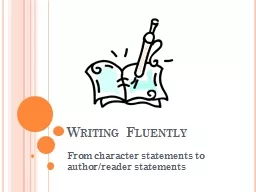

From character statements to authorreader statements Spot the difference EXAMPLE A Gatsby is obsessed with Daisy Elizabeth doesnt like Darcy at the start of the novel EXAMPLE B Fitzgerald explores Gatsbys obsession with Daisy ID: 474972
Download Presentation The PPT/PDF document "Writing Fluently" is the property of its rightful owner. Permission is granted to download and print the materials on this web site for personal, non-commercial use only, and to display it on your personal computer provided you do not modify the materials and that you retain all copyright notices contained in the materials. By downloading content from our website, you accept the terms of this agreement.
Slide1
Writing Fluently
From character statements to author/reader statementsSlide2
Spot the difference:
EXAMPLE A:
Gatsby is obsessed with Daisy
Elizabeth doesn’t like Darcy at the start of the novel
EXAMPLE B:
Fitzgerald explores Gatsby’s obsession with Daisy
The reader is positioned to explore Gatsby’s initial obsession with Daisy Slide3
Key differences
EXAMPLE A – Character
statements
EXAMPLE B –Author/reader statements
Focus
on the characters’ worlds
Focus
on the author’s construction of meaning or the reader’s interpretations
Simplistic
Complex
Treats
the characters like they are real people – one-dimensional view of the text
Treats the characters like they are vehicles through which authors
convey messages and readers interpret meaning
Descriptive/summary
Analytical/evaluative
Lower-order thinking
Higher-order thinking Slide4
How do I transform my sentences into author/reader statements:
Author statements usually start with the author’s name
, followed by a
verb/s describing
what the author is
doing
:
Eg
: ‘
Harwood’s
use of
pseudonyms, masks and disguises
highlights
the nature of perspective in interpretation’
To transform your sentences, simply begin your sentence with the author’s name, followed by a verb, followed by what the author is attempting to do/achieve with their writing Slide5
Reader statements
Reader statements typically start with the words ‘Readers’
or ‘
The audience’,
followed by a
verb/s describing
the effects on readers
:
Eg
: ‘
Audiences
are
positioned to
immerse themselves in the unfamiliar world of each character,
reinforcing the chaotic sense of displacement they experience throughout the play.’
To transform your sentences, simply
begin your sentence with the
words ‘Readers’ or ‘The audience’ followed
by a verb, followed by
what specific effect the writing has on readersSlide6
Mixing it up: Using prepositions
Alternatively, each of these statements can start with a
preposition
(
eg
: A word indicating place
or a relationship between two words, such
as “in”, “throughout”,
“by”, “through
”) followed by a phrase about the
author/readers:
Eg
: ‘
Through
representing Daisy as self-serving
and superficial,
Fitzgerald critiques
the materialism and destructive tendencies of affluence in 1920s US society’
‘
By
imbuing the poem ‘Iris’ with religious symbolism such as “the ark” which “sail[s]” across the seas “wave after wave”, Harwood’s imagery is reminiscent of Noah’s Ark, leaving readers with a sense of moral salvation’
Feel free to mix it up!Slide7
Some useful ‘author statement’ verbs:
Author
verbs
Conveys
Underscores
Engulfs
Imbues
Exemplifies
Portrays
Suggests
Illustrates
Foreshadows
Connotes
Elucidates by way of…
Dissects
Illustrates
Establishes
Symbolises
Captures
Condemns
Perpetuates
Reinforces
Endorses
Reveals
Evinces
Explores
Engenders
Creates
Celebrates
Challenges
Serves
Laments
Confirms
Slide8
Some useful ‘reader statement’ verbs
Reader verbs
Manoeuvred
Observe
Succumb
to
Interpret
Positioned
…are confronted with…
Positioned to
Discover
Encouraged
Form connections
between
Come
to the dawning realisation
…are invited to …
Solidify
Dislocate
Feel
Condemn…
Connect
Disassociate
Ponder
…are
led to…
Reconsider
Prompting a visceral
response
Strikes a
sense of…
Differentiate between…
Discern
Revisit
Draw parallels between
Re-evaluate
…are left
with
Empathise with
…reminiscent of
Question
Witness
Peer through
Builds
hope/tension
Admire
Obtain a
sense of…
Transfer
Revile
Esteem Slide9
Some sentence starters…
Through the character of....the author/director...challenges the
idea/notion/ belief
that
....
By portraying [character/setting] as ….., [author] creates the sense that…
*In the world of the text....the
author/director
represents a society
that believes/accepts/values....
Through the portrayal of … as…, readers are encouraged to draw parallels between…
During [scene], the audience comes to the dawning realisation that…through…